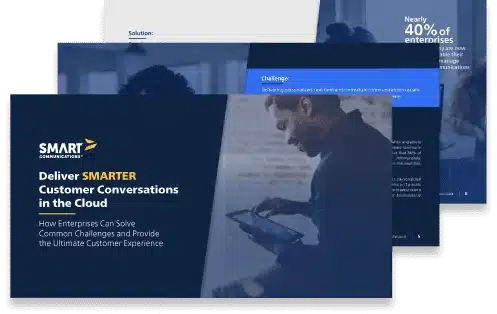How to Create Digital-First Patient Intake Forms
By: John Zimmerer, VP of Healthcare Marketing at Smart Communications
Whether visiting a primary care physician, clinic or specialist, patients will need to complete a patient intake form to help provide staff with the valuable information they need to see patients as individuals. Over time, it’s obvious that these forms are substantially the same for every provider, even those in the same practice or system. And, it’s not typically a single form; depending on the practitioner and the reason for making an appointment, there are usually multiple forms to fill out, especially for new patients.
What’s worse is that patients are often required to fill out generic, paper forms full of fields asking for information that the provider or practice may already have access to, even if the patient had already completed substantially the same forms online (e.g., when prompted to do so via an appointment confirmation or reminder email). Many of the questions often do not apply to an individual patient’s unique medical situation, creating confusion and frustration for patients. This provides a terrible patient experience and can set the provider-patient relationship off on the wrong foot.
In this post, we show providers that there’s a better way—a modern, digital-first alternative to the manual patient intake forms provided by legacy systems. One that leverages the power of the cloud and can save providers money while saving both patients and practitioners time. Let’s get started by identifying a few common forms in the healthcare industry:
Medical History Forms
This form requires patients to document all prior diagnoses, treatments and surgeries, any medications they are currently prescribed or taking, current condition and symptoms as well as family medical history. This is all considered protected health information (PHI). The form also asks for personally identifiable information (PII), including the patient’s name, date of birth and contact information. All this information must be protected once collected. Collecting this information on a paper-based patient intake form can open the door for data to be compromised.
RELATED READING | ‘Optimizing the Patient Experience with a No-Code Patient Appointment System’
Patient Authorization Forms
Governments and other regulatory bodies often dictate that practitioners obtain a patient’s explicit permission regarding how their medical information will be handled. This often includes:
- Consent to release medical records (including any prior films, scans and other medical records).
- Patient consent to bill an insurance carrier and authorization to send the patient, providers and attorney and/or personal representative information electronically. At the very least, a patient must sign an acknowledgment that they have received a copy of the provider’s privacy notice.
Consent to Treatment Forms
Many practices, especially hospitals and clinics, will require patients to complete a form acknowledging that they consent to be treated and informing them of their rights to discuss or refuse any procedure or treatment. If the patient is a minor or vulnerable adult, the form must be signed by the parent or guardian and may also need to be witnessed by another person.
Patient Responsibility Forms
This form requests acknowledgment that the patient is ultimately responsible for the payment for any services rendered or products provided during a visit, including any co-pays, co-insurance, deductibles and more. The form usually informs a patient when payment is due and the acceptable methods of payment.
Designing a Secure, Digital Forms Experience
As highlighted above, the number and types of forms involved in healthcare can be major points of friction for patients. The old, manual way of managing patient intake forms is singularly focused on data collection rather than the necessary holistic approach to managing a patient-first digital forms experience.
A truly secure, digital solution for patient intake forms should be able to consolidate all the above forms into a single interview that can be started, paused, resumed and completed on any device, including a mobile phone or tablet. The right digital solution should be able to reach into a provider’s electronic medical record system (e.g., athenahealth, Cerner or EPIC) and pull in a patient’s PII or PHI for them to review and revise rather than rekey. It should also be capable of personalizing and tailoring patient intake form questions to an individual’s unique medical situation. And, the ability to integrate with digital signature solutions to eliminates the need to print, sign, shuttle and hand in, mail or fax these forms.
Given the increased focus on privacy and security due to all-too-frequent reports of compromised systems, as well patients’ increased appetite for digital engagement, it’s more important than ever for healthcare providers to invest in products and platforms that safeguard their customers’ PHI and PII. Solutions that are HIPAA-, ISO- and SOC-certified by independent third parties are proven capable of safeguarding patient data from hacks and data breaches.
KEEP READING | ‘The Powerful Combination of E-signature and Digital Forms Takes Customer Experience to a New Level’
A Trusted Solution to Help Streamline Patient Intake Forms
Providers, especially hospital systems, often need to support multiple brands. Modern digital forms solutions like SmartIQ from Smart Communications employ a layered model that separates form elements from styling and branding. It maximizes the use of reusable form fragments, allowing for the same form elements to be created once and then used across multiple forms. This also simplifies translation efforts and minimizes the effort to comply with accessibility standards.
Forms frequently need to go through multiple levels of internal reviews. Modern forms solutions incorporate workflow functionality that can bring stakeholders together to review and quickly revise forms to get them into production quickly.
Smart Communications has helped reinvent all manner of forms for healthcare providers that rely on its ISO-certified and HIPAA-compliant Conversation Cloud platform. We have helped increase their efficiency by as much as 80% and to improve the patient experience in the process.
Our products, professional services and partners have already helped dozens of healthcare providers simplify the task of creating and maintaining patient intake and other forms.



